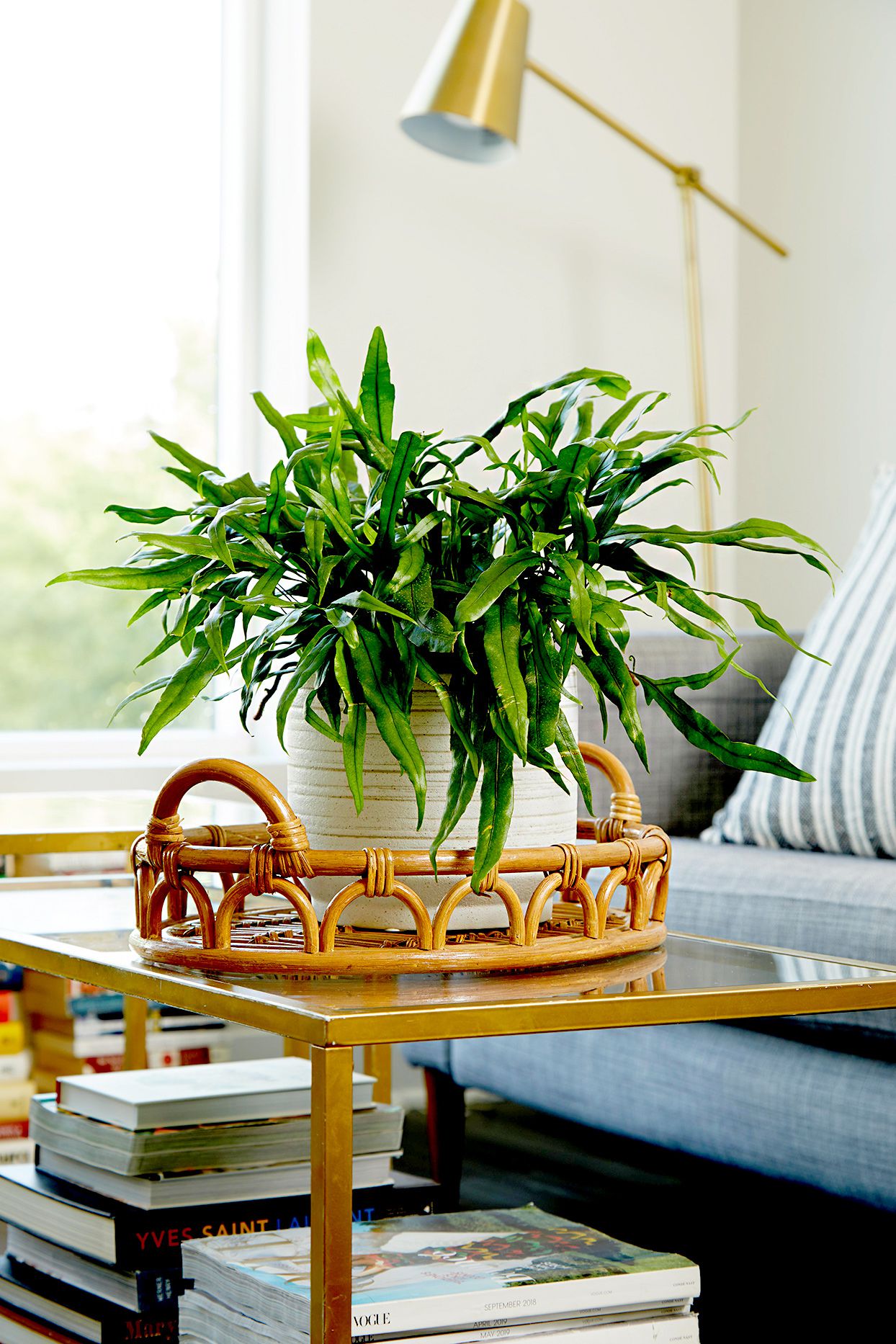Many types of indoor ferns add a lush, tropical look to any room. This diverse group of plants comes in an array of colors and textures, including delicate, lacy fronds and smooth, substantial foliage. Here are nine recommendations to get you started, plus tips for indoor fern care and display ideas.
Staghorn Fern
This indoor fern draws attention for two reasons: their namesake forked fronds that look a bit like antlers and their unique growth. Staghorns are epiphytes, which means that in nature, they grow on other plants (but they aren’t parasites on the host plant). So they don’t need to grow in a pot of soil like other plants do. Instead, use them as statement-making displays, like mounted on boards hung on the wall. Water them like you would air plants, by misting them every day or soaking them in water weekly.
Name: Platycerium bifurcatum
Growing Conditions: Medium to bright light and high humidity
Size: Up to 3 feet tall and wide
Maidenhair Fern
Maidenhair has a reputation for being somewhat challenging to grow indoors. That’s because they love moisture, meaning they need lots of water and humidity. So if you’re aserial over-waterer, this is the plant for you. Throw in a daily misting or two, and these ferns will reward you with fine-textured fronds on long, black, wiry stems.
Name: Adiantum raddianum
Growing Conditions: Medium to bright light and high humidity
Size: Up to 2 feet tall and wide
Lemon Button Fern
This indoor fern is cute as a button with its tiny, golden-green, rounded leaflets (that give it the namesake buttonlike appearance). Those long, arching fronds work well in hanging baskets or a tabletop terrarium. The unfussy plant lends lushness to any decorating style.
Name: Nephrolepis cordifolia ‘Lemon Button’
Growing Conditions: Medium to bright light and high humidity
Size: Up to 3 feet tall and 4 feet wide
Kangaroo Paw Fern
Shiny, dark green fronds grow into an unkempt mound reminiscent of Medusa’s hair. Native to Australia, this indoor fern got its name from its long leaves, similar to a kangaroo’s large feet. Like rabbit’s foot fern, it features thick rhizomes that may creep down the sides of its container.
Name: Microsorium diversifolium (syn. Phymatosorus)
Growing Conditions: Medium to bright light and average humidity
Size: Up to 2 feet tall and wide
Crocodile Fern
The straplike, bright green leaves (called fronds on ferns) have a decidedly reptilian, scaly look that doesn’t align with what most people picture as a fern. Crocodile ferns’ fronds also explain their common name. When fully grown, they make quite a statement, often reaching 2-3 feet long.
Name: Microsorium musifolium ‘Crocodyllus’
Growing Conditions: Medium to low light and high humidity
Size: Up to 3 feet tall and wide
Rabbit’s Foot Fern
This beautiful indoor fern features dark green, fine-textured, dainty-looking fronds and fuzzy rootlike stems (rhizomes) that creep down the side of its pot or along the soil. Grayish-white hairs cover the rhizomes that inspired its common name. Show off (or even pet) those rhizomes by displaying these ferns in hanging planters.
Name: Humata tyermanii
Growing Conditions: Medium to bright light and high humidity
Size: to 2 feet tall and wide
Bird’s Nest Fern
Phoebe Cheong
Leathery fronds with wavy edges radiate from the center of the plant to create a striking vase shape that vaguely resembles a nest. Because these indoor ferns love high humidity, they’re great plants to grow in your bathroom, if you have a window providing plenty of indirect light.
Name: Asplenium nidus
Growing Conditions: Medium to bright light and high humidity
Size: Up to 5 feet tall and wide (but usually 1-2 feet indoors)
Silver Brake Fern
We love the two-tone foliage on this eye-catching plant, which also goes by the names silver lace fern and slender brake ferns. Each frond has several narrow leaflets with a pale silvery strip down the middle. The leaflets also have crested (or branched) tips. Keep this moisture-loving indoor fern happy by never letting the soil completely dry out between waterings.
Name: Pteris cretica ‘Mayi’
Growing Conditions: Medium to bright light and high humidity
Size: Up to 2 feet tall and wide
Cotton Candy Boston Fern
Boston ferns make excellent houseplants because they aren’t too picky about anything beyond getting regular watering and some bright, indirect light. They have course-texture fronds and can get quite large at maturity. Some varieties stay small (like ‘Cotton Candy’, shown here, which we love for its extra-fine, feathery fronds).
Name: Nephrolepis exaltata ‘Cotton Candy’
Growing Conditions: Medium to bright light and average humidity
Size: Up to 1 foot tall and wide
Indoor Plants to Add Greenery to Your Home
Indoor plants can be just what your home needs to add a natural element that will warm up your rooms and add a hint of the outdoors. If you’re new to caring for plants, these low-maintenance choices will make it easy to get started. For flower lovers, these colorful, blooming plants bring plenty of vibrant hues to your space. High ceilings can sometimes make a room feel cold and stark, but adding one or two tall plants, especially in corners, can easily remedy that problem. To help your indoor plants thrive, choose the right fertilizer and follow these tips for the best watering.
Pick Out Coordinating Planters
Pick some uniquely textured or colorful planters to coordinate with your interior design. You can use vintage and salvaged items for planters—just add drainage holes to prevent root rot. You can make unique hanging planters to add interesting shapes, including a trellis wall planter and an air-plant mobile that will be a conversation starter. If your indoor plants start to take over your home, it may be time to create a garden room where they can live happily together.

